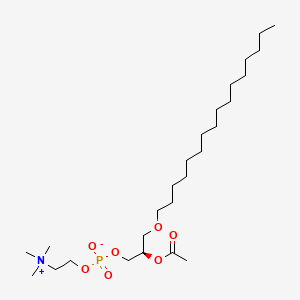| MeSH term | MeSH ID | Detail |
|---|---|---|
| Burns | D002056 | 34 associated lipids |
| Pancreatic Neoplasms | D010190 | 77 associated lipids |
| Inflammation | D007249 | 119 associated lipids |
| Reperfusion Injury | D015427 | 65 associated lipids |
| Colitis | D003092 | 69 associated lipids |
| Colonic Neoplasms | D003110 | 161 associated lipids |
| Diabetes Mellitus, Type 1 | D003922 | 56 associated lipids |
| Diabetes Mellitus, Type 2 | D003924 | 87 associated lipids |
| Diabetic Retinopathy | D003930 | 39 associated lipids |
| Infertility, Male | D007248 | 11 associated lipids |
Platelet activating factor
Platelet activating factor is a lipid of Glycerophospholipids (GP) class. Platelet activating factor is associated with abnormalities such as Atherosclerosis, Acute cholecystitis without calculus, Cholecystitis, Colitis and Cholecystitis, Acute. The involved functions are known as Cell Survival, Metabolic Inhibition, lipid oxidation, Apoptosis and Oxidation. Platelet activating factor often locates in soluble, Cellular Membrane, Smooth muscle (tissue), Intima and Tissue specimen. The associated genes with Platelet activating factor are apolipoprotein A-I Milano, Homologous Gene, TSPO gene, HBEGF gene and SLC33A1 gene. The related lipids are Hydroxycholesterols, Liposomes, 25-hydroxycholesterol, Lysophosphatidylcholines and Lipopolysaccharides. The related experimental models are Knock-out, Mouse Model and Transgenic Model.
Cross Reference
Introduction
To understand associated biological information of Platelet activating factor, we collected biological information of abnormalities, associated pathways, cellular/molecular locations, biological functions, related genes/proteins, lipids and common seen animal/experimental models with organized paragraphs from literatures.
What diseases are associated with Platelet activating factor?
Platelet activating factor is suspected in Ischemia, Pleurisy, Atherosclerosis, Inflammatory disorder, Retinal Diseases, Diabetes and other diseases in descending order of the highest number of associated sentences.
Related references are mostly published in these journals:
| Disease | Cross reference | Weighted score | Related literature |
|---|
Possible diseases from mapped MeSH terms on references
We collected disease MeSH terms mapped to the references associated with Platelet activating factor
PubChem Associated disorders and diseases
What pathways are associated with Platelet activating factor
There are no associated biomedical information in the current reference collection.
PubChem Biomolecular Interactions and Pathways
Link to PubChem Biomolecular Interactions and PathwaysWhat cellular locations are associated with Platelet activating factor?
Visualization in cellular structure
Associated locations are in red color. Not associated locations are in black.
Related references are published most in these journals:
| Location | Cross reference | Weighted score | Related literatures |
|---|
What functions are associated with Platelet activating factor?
Related references are published most in these journals:
| Function | Cross reference | Weighted score | Related literatures |
|---|
What lipids are associated with Platelet activating factor?
Related references are published most in these journals:
| Lipid concept | Cross reference | Weighted score | Related literatures |
|---|
What genes are associated with Platelet activating factor?
Related references are published most in these journals:
| Gene | Cross reference | Weighted score | Related literatures |
|---|
What common seen animal models are associated with Platelet activating factor?
Knock-out
Knock-out are used in the study 'A cardioprotective role for platelet-activating factor through NOS-dependent S-nitrosylation.' (Leary PJ et al., 2008).
Mouse Model
Mouse Model are used in the study 'A regulatory role of LPCAT1 in the synthesis of inflammatory lipids, PAF and LPC, in the retina of diabetic mice.' (Cheng L et al., 2009).
Transgenic Model
Transgenic Model are used in the study 'Heterogeneity in the sn-1 carbon chain of platelet-activating factor glycerophospholipids determines pro- or anti-apoptotic signaling in primary neurons.' (Ryan SD et al., 2008).
Related references are published most in these journals:
| Model | Cross reference | Weighted score | Related literatures |
|---|
NCBI Entrez Crosslinks
All references with Platelet activating factor
Download all related citations| Authors | Title | Published | Journal | PubMed Link |
|---|---|---|---|---|
| Kulinski JM et al. | Sphingosine-1-phosphate and other lipid mediators generated by mast cells as critical players in allergy and mast cell function. | 2016 | Eur. J. Pharmacol. | pmid:25941085 |
| Vadas P | The platelet-activating factor pathway in food allergy and anaphylaxis. | 2016 | Ann. Allergy Asthma Immunol. | pmid:27788869 |
| Pike DP et al. | Platelet-Activating Factor Quantification Using Reversed Phase Liquid Chromatography and Selected Reaction Monitoring in Negative Ion Mode. | 2016 | Lipids | pmid:27757707 |
| Wang M et al. | The responses of pulmonary and systemic circulation and airway to anaphylactic mediators in anesthetized BALB/c mice. | 2016 | Life Sci. | pmid:26808090 |
| Bihl JC et al. | UVB Generates Microvesicle Particle Release in Part Due to Platelet-activating Factor Signaling. | 2016 | Photochem. Photobiol. | pmid:26876152 |
| Reiner B et al. | Platelet-activating factor attenuation of long-term potentiation in rat hippocampal slices via protein tyrosine kinase signaling. | 2016 | Neurosci. Lett. | pmid:26808643 |
| Unsal E et al. | Effects of pentoxifylline and platelet activating factor on sperm DNA damage. | 2016 | Eur. J. Obstet. Gynecol. Reprod. Biol. | pmid:26748389 |
| Park JH et al. | Glucosamine suppresses platelet-activating factor-induced activation of microglia through inhibition of store-operated calcium influx. | 2016 | Environ. Toxicol. Pharmacol. | pmid:26745504 |
| RodrÃguez M et al. | Pharmacological inhibition of eicosanoids and platelet-activating factor signaling impairs zymosan-induced release of IL-23 by dendritic cells. | 2016 | Biochem. Pharmacol. | pmid:26673542 |
| Kim HK et al. | Glutamine Prevents Late-Phase Anaphylaxis via MAPK Phosphatase 1-Dependent Cytosolic Phospholipase A2 Deactivation. | 2016 | Int. Arch. Allergy Immunol. | pmid:27838690 |
